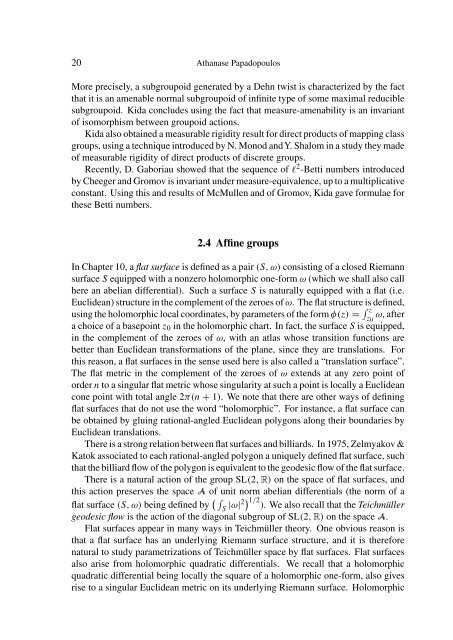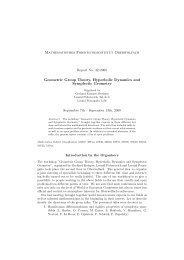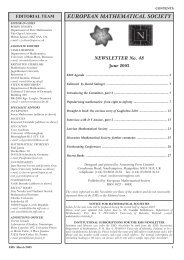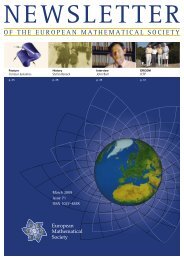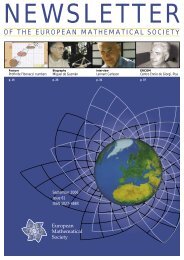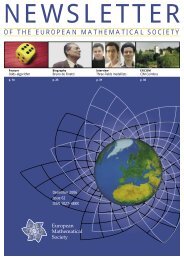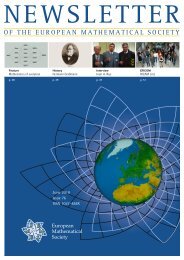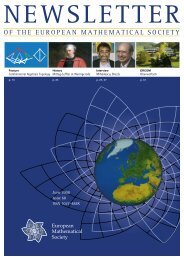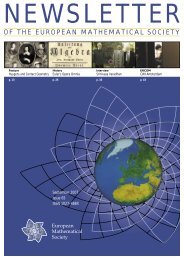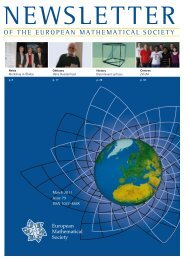Introduction to Teichmüller theory, old and new, II
Introduction to Teichmüller theory, old and new, II
Introduction to Teichmüller theory, old and new, II
You also want an ePaper? Increase the reach of your titles
YUMPU automatically turns print PDFs into web optimized ePapers that Google loves.
20 Athanase Papadopoulos<br />
More precisely, a subgroupoid generated by a Dehn twist is characterized by the fact<br />
that it is an amenable normal subgroupoid of infinite type of some maximal reducible<br />
subgroupoid. Kida concludes using the fact that measure-amenability is an invariant<br />
of isomorphism between groupoid actions.<br />
Kida also obtained a measurable rigidity result for direct products of mapping class<br />
groups, using a technique introduced by N. Monod <strong>and</strong>Y. Shalom in a study they made<br />
of measurable rigidity of direct products of discrete groups.<br />
Recently, D. Gaboriau showed that the sequence of ℓ 2 -Betti numbers introduced<br />
by Cheeger <strong>and</strong> Gromov is invariant under measure-equivalence, up <strong>to</strong> a multiplicative<br />
constant. Using this <strong>and</strong> results of McMullen <strong>and</strong> of Gromov, Kida gave formulae for<br />
these Betti numbers.<br />
2.4 Affine groups<br />
In Chapter 10, a flat surface is defined as a pair (S, ω) consisting of a closed Riemann<br />
surface S equipped with a nonzero holomorphic one-form ω (which we shall also call<br />
here an abelian differential). Such a surface S is naturally equipped with a flat (i.e.<br />
Euclidean) structure in the complement of the zeroes of ω. The flat structure is defined,<br />
using the holomorphic local coordinates, by parameters of the form φ(z) = z<br />
ω, after<br />
z0<br />
a choice of a basepoint z0 in the holomorphic chart. In fact, the surface S is equipped,<br />
in the complement of the zeroes of ω, with an atlas whose transition functions are<br />
better than Euclidean transformations of the plane, since they are translations. For<br />
this reason, a flat surfaces in the sense used here is also called a “translation surface”.<br />
The flat metric in the complement of the zeroes of ω extends at any zero point of<br />
order n <strong>to</strong> a singular flat metric whose singularity at such a point is locally a Euclidean<br />
cone point with <strong>to</strong>tal angle 2π(n + 1). We note that there are other ways of defining<br />
flat surfaces that do not use the word “holomorphic”. For instance, a flat surface can<br />
be obtained by gluing rational-angled Euclidean polygons along their boundaries by<br />
Euclidean translations.<br />
There is a strong relation between flat surfaces <strong>and</strong> billiards. In 1975, Zelmyakov &<br />
Ka<strong>to</strong>k associated <strong>to</strong> each rational-angled polygon a uniquely defined flat surface, such<br />
that the billiard flow of the polygon is equivalent <strong>to</strong> the geodesic flow of the flat surface.<br />
There is a natural action of the group SL(2, R) on the space of flat surfaces, <strong>and</strong><br />
this action preserves the space A of unit norm abelian differentials (the norm of a<br />
<br />
flat surface (S, ω) being defined by S |ω|2 1/2<br />
). We also recall that the <strong>Teichmüller</strong><br />
geodesic flow is the action of the diagonal subgroup of SL(2, R) on the space A.<br />
Flat surfaces appear in many ways in <strong>Teichmüller</strong> <strong>theory</strong>. One obvious reason is<br />
that a flat surface has an underlying Riemann surface structure, <strong>and</strong> it is therefore<br />
natural <strong>to</strong> study parametrizations of <strong>Teichmüller</strong> space by flat surfaces. Flat surfaces<br />
also arise from holomorphic quadratic differentials. We recall that a holomorphic<br />
quadratic differential being locally the square of a holomorphic one-form, also gives<br />
rise <strong>to</strong> a singular Euclidean metric on its underlying Riemann surface. Holomorphic


